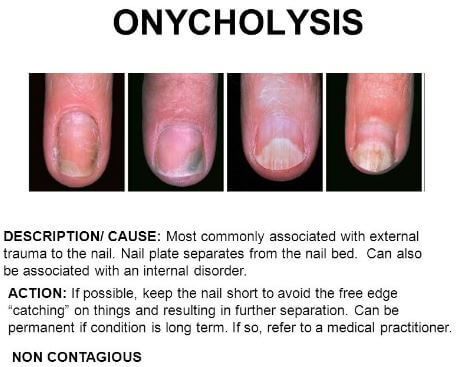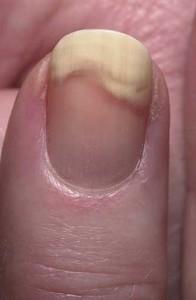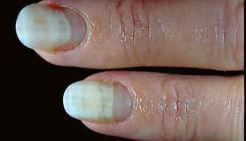What is Onycholysis?
Onycholysis is one of the disorders that affect nails. This condition causes your nail to separate from its nail bed4.

Causes
There are several causes of onycholysis, and they include:
Repetitive injury
You can develop this disorder when an injury occurs repetitively on your fingers and toes. For example, you can knock your toe on a hard surface while walking or running which weakens your nails causing it to be lifted out of its nail bed.

Another example is when you tap your fingers on a counter on daily basis may also lift the nail on your finger out of its bed.
Nail remover tools
Nail removal tool such as those used during manicure may be pushed below your nail during cleaning. This may make your nails weaker and easily be raised from its bed.
Also manicure equipment such as nail clippers used at a nail centre may not be sanitized; this may lead to spread of fungi infections from infected persons to you.
Excess moisture
Too much moisture from solvents applied on your nails make them brittle. Brittle nails can easily break from underneath your skin and be lifted up.
Medical conditions
Some medical conditions are also considered as causes of onycholysis. They weaken the soft tissue below your nail so that the nail fails to attach properly to the nail bed. These medical conditions include:
Psoriasis
Psoriasis is a skin condition that is marked with abnormal growth of skin cells. The cells that are below your skin may eventually die when they reach the surface of your skin.
This leads to elevated red plagues enclosed with white scales. This condition can affect your palms, torso and soles but commonly happens on your elbows, knees and scalp.
The disorder may weaken your toenails and fingernails and cause them to easily detach from the nail bed.
Fungal infections
Fungi are found on and inside your body. When they are too many in your body they cause an infection.
Your nails can be infected when fungi present in, on and under your nail increases in population. Fungi attack the tissue below your nail plate making it thick hence causing the edge of your nail to rise up.
Fungi also thrive well when your nails or areas around the nails are warm or humid. This environment promotes the growth of fungi. Another means through which you can get fungi infection is when you come into contact with a person with fungi infection. The infected person will transfer fungi on to your skin.
Your toenails are more likely to be infected with fungi than your fingernails because toes are confined in a moist environment in the shoe.
Other causes
Medication: Tetracycline is a type of antibiotic used to treat bacterial infection. When you have taken this drug, avoid exposing yourself to direct sunlight or ultra violet rays from sunlamps.
Tetracycline increases the sensitivity of your skin to sunlight and as a result your nails react to this exposure. This reaction may weaken your nails hence causing them to be lifted from their nail bed.
Symptoms
People with onycholysis will exhibit different symptoms depending on the cause of this disorder. Generally, you will notice uneven border between the pink part and the outer white edge of your nail.

A larger part of your nail may appear yellow, green, discolored or white. Below the edge of your nail plate, the skin there appears very thick and also nail plate have a distorted shape.
Diagnosis
Onycholysis is first diagnosed through a physical examination. Your doctor examines your toes and fingernails and notes characteristics on your nails such as colour, shape, form of the skin below and around the nail. In addition, your doctor will look at your skin for any skin rashes.
Other tests can be conducted to determine the cause of the infection. Your doctor can take a sample of a tissue below your nail and assesses it in the laboratory to determine if it’s a fungi infection.
Treatment
Onycholysis treatment depends on its underlying cause. Your doctor may prescribe the following:
Antibiotics: If you have a bacterial infection, your doctor may prescribe antibiotics to treat it.
Antifungal drugs: Avoid over-the- counter antifungal drugs because they are ineffective in curing nail infection. Always get antifungal medicines prescribed by your doctor. Your doctor may recommend the following antifungal drugs:
- Griseofulvin
- Fluconazole
- Itraconazole
Your doctor may also give you topical antifungal lotion to use. Brush the lotion on your nails the same way you apply a nail polish. You may have to use these medications for several months for effective results. Topical lotions are generally ineffective in curing your toenail infections.
Although, there are fungi treatments, there is no assurance that they will totally eliminate all fungi infection. In some case, you may still be infected after a certain period.
Prevention
You can make simple lifestyle changes to protect your nails from onycholysis. The following are some preventive measures you can embrace to take good care of your nails:
- Trim your nails properly so that they can endure daily trauma of your life like tapping.
- Put on rubber gloves to avoid repetitive contact with water.
- Keep away from nail remover chemicals that are harsh
- Dry your feet and between toes properly with a towel after taking a bath.
- Buy and use your own equipment for manicure or pedicure.
- Use antifungal powders or sprays often
- Minimize use of nail polish.
Treatment at home
Natural remedies can help you prevent fungi and bacterial infection of the nails. The following are some natural remedies you can prepare at home and apply on your toenails and fingernails:
- Tea tree or orange oil has anti-bacterial as well as fungicidal properties to help eliminate both bacteria and fungi on, in and under your nails. It is simple to prepare tea tree or orange rub. First, you need take a teaspoon of tea tree, then mix it with ½ teaspoons of orange oil and olive oil, or grape seed. Now, insert cotton into the mixture and apply it on the affected nails and press the cotton gently to remove liquid.
- You can also put some water in a basin and add 5 drops of tea tree and immerse your feet in. Wait for about 20 minutes. Do this twice each day; morning and evening.
Reference List
- Onycholysis – Definition, Causes, Symptoms, Pictures and Treatment. Available at http://www.primehealthchannel.com/onycholysis-definition-causes-symptoms-pictures-and-treatment.html
- https://www.drugs.com/health-guide/onycholysis.html
- https://www.drugs.com/tetracycline.html
- http://emedicine.medscape.com/article/1105738-overview?
- Natural remedies for Oncholysis. Available at http://everydayroots.com/how-to-get-rid-of-toenail-fungus
- Oncholysis – http://www.aocd.org/?page=onycholysis
- http://www.nailsmag.com/article/91567/the-nail-doctor-onycholysis-or-nail-separation-has-different-varieties
- Oncholysis – http://www.healthline.com/health/onycholysis#causes2
- http://www.webmd.com/skin-problems-and-treatments/psoriasis/understanding-psoriasis-basics#1
- http://www.healthline.com/health/fungal-nail-infection#overview1
